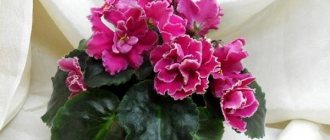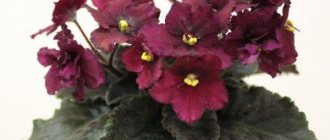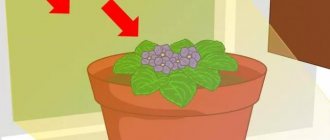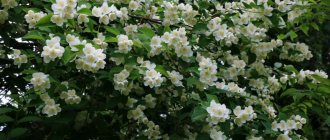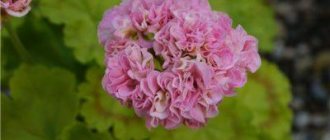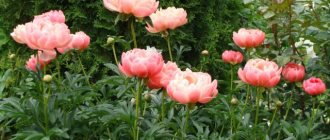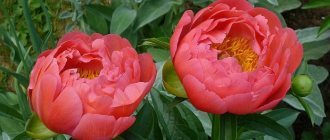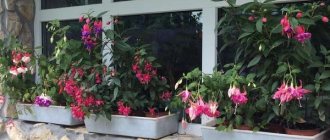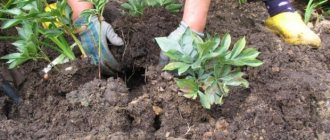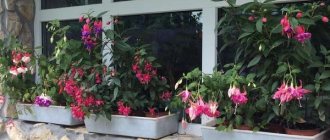Skip to content
Instagram VK
Tel. 8-996-686-71-22 (VIBER, WhatsApp). Email: [email protected] x.ru
Cvetovod86 cuttings and flower seedlings
Search
Cart / 0 ₽ 0
Cvetovod86 cuttings and flower seedlings
Instagram VK
Cart / 0 ₽ 0
70 ₽
Petunia Surfinia "Giant Purple" - rooted cuttings
SKU: 300 Category: petunia SURFINIA Tags: petunia, surfinia, rooted petunia cuttings, petunia cuttings. Surfinia. Surfinia cuttings, Surfinia cuttings
- Description
- Reviews (0)
Surfinia is a separate group of petunias, bred in Japan. It is distinguished by its strong and powerful growth. The length of the lashes reaches 1.5 meters.
Surfinia Giant Purple is distinguished by its strong and active growth, even in the seedling stage it produces long lashes and grows in the form of a spider. After planting in a permanent place, it quickly gains length and blooms until frost. Flowering lasts along the length of the entire shoot. The bush grows in a plane (like all hanging plants), so it should be planted at eye level or higher; hanging plants are not suitable for flower beds. The volume of soil for surfinia needs at least 15 liters. then she will show all her power.
Resistance to negative climatic conditions
Most varieties of petunias struggle negatively with bad weather conditions. In windy weather, the petunia's petals almost open from the stem, and in rainy weather, the petunia loses its shape. When it rains, it is recommended to hide containers with plants under a canopy. But such a measure is not always practical or convenient.
The Surfinia variety does not suffer from bad weather; it does not need to be covered with anything. The only thing that can be done is to remove the leaves that have been damaged by the rain. The flower is able to grow new petals in a short time. Petunia will not lose its beautiful appearance from such a process.
The variety is classified as an ampelous variety, but it is very easy to confuse it with other varieties.
Varieties of petunias. How to understand their diversity?
Petunia, an amazingly beautiful flower from the Tobacco genus, is very popular among gardeners. Nowadays numerous hybrids of this garden crop are used for breeding. All varieties of petunias are divided into several large groups, within which there are many different varieties. The division into groups is based on differences in the size and external characteristics of plants.
According to their shape, plants can be divided into bush-like and cascading, or ampelous.
Bush petunias are divided into several groups based on flower size:
- Petunia Grandiflorum (grandiflora). This group is especially popular. It includes varieties of petunias with very large flowers (up to 12 cm) in the most fantastic colors. Grandifloras include more than one hundred varieties and various hybrids. For example, there are varieties such as Grandiflora Low-growing, Excellent, Large Terry, etc. Large-flowered petunias are especially good for container propagation.
- Petunia Multiflorum (multiflora) are multi-flowered varieties with a whole sea of not very large, but unpretentious flowers, resistant to rain, wind and other climatic conditions of the middle zone. The average diameter of the flowers of these varieties is about 5 cm, they are smooth and simple. They are suitable for growing in hanging baskets or in a trailing form.
- Petunia Floribunda. This is a transitional form between multi-flowered and large-flowered petunias. Its flowers are larger than those of multi-flowered ones. Some varieties of petunias of this form have double flowers, some have simple flowers.
- Petunia Milliflorum (small-flowered) - has flowers no larger than 2.5 cm. This is a rain-resistant, low-growing (no more than 15 cm) variety.
Ampelous petunia differs from bush petunia by longer hanging, cascading stems more than a meter long. Varieties of this group are planted in hanging flower pots, in boxes on balconies, or used to decorate the slopes of an alpine hill. Among them are the following groups:
- Calibrachoa are small-flowered varieties of petunias with long hanging shoots that reproduce only vegetatively.
- Surfinia, whose flowers can reach 8 cm. Reproduction is also only vegetative.
- Cascade petunias, or supertunias. They can be propagated both by seeds and vegetatively. All three varieties are characterized by a special decorative effect.
- Among the ampelous petunias, there are also semi-ampeloid ones, with shorter stems.
The newest varieties of petunias are characterized by unusual colors. For example, in England in 2011, a variety with black petals was developed. This is the first such plant among petunias. Variety name: Black Velvet.
Among the new floribundas one can note the profusely flowering petunia F1 Niagara Falls, which is characterized by a beautiful appearance, large, up to 7 cm, satin flowers of various colors, friendly flowering and unpretentiousness.
Among the new large-flowered varieties of petunia, the hybrid F1 Ostrich Feather is good, with unusually large spherical flowers with a jagged edge. When grown in a flower bed, a plant of this variety can create a flowering carpet with a diameter of one and a half square meters. This hybrid is perfect for growing in pots, on balconies and in baskets.
It is difficult to select the best varieties of petunias, because each is good in its own way, and they are all very beautiful. Thus, among ampelous petunias, such no longer new varieties as Lilac Surf, amazing Pearl Surf, and Waterfall have proven themselves well. Among the Calibrachoas, Calibrachoa Million is distinguished, creating entire waterfalls of small but beautiful flowers.
When buying petunias for propagation, you need to pay attention to the shape of the bush. It depends on what planting it is better to use them for.
When propagating by seeds, only seeds of F1 hybrids should be taken. If you want to get plants of the same appearance next year, use vegetative propagation of these flowers by cuttings.
fb.ru
Description of culture
The culture is a hybrid of the well-known petunia. This unique plant differs from the basic variations in its powerful two-meter shoots, decorated with a “waterfall” of large flowers. Depending on the method of planting the plant, its shape may be different. A ball or a spectacular cascade is the choice of the gardener.
Surfinia appeared as a result of attempts by Japanese breeders to adapt petunia to unfavorable weather. The result is this large-flowered ampelous variety. It reproduces only by cuttings.
The flowers of the plant reach a diameter of 9 cm. The color can be either single or combined. Usually the pharynx stands out against the background of the general shade. Contrasting veins or borders can give flowers a distinct personality. Petals can be either regular or double.
Hybrid features:
- resistance to any climatic conditions (neither rain nor strong wind can damage the beauty of the bushes);
- early and long flowering, pleasing with an abundance of beautiful buds;
- a wide variety of varieties, and therefore shapes and shades of flowers;
- excellent immunity that protects against diseases and pests;
- fast growing season (surfinia can become a full-fledged plant in a couple of months).
Add a comment Cancel reply
You must be logged in to post a comment.
This is the first yellow ampelous surfinia. The shoots first grow vertically, then droop in a cascade, forming a large ball. The bush branches well, but requires pinching. The color is bright enough for petunias, flowering is mid-late. For one plant 7-10 liters. Planting pattern 80x80 cm
- Author: Maria Sukhorukikh
Rate this article:
- 5
- 4
- 3
- 2
- 1
(0 votes, average: 0 out of 5)
Share with your friends!
Plant Features
All modern cultivated varieties of petunia are obtained as a result of hybridization of wild species originating from South America, and are distinguished by a variety of colors and shapes.
Petunia
Petunia belongs to the nightshade family, a genus of perennial herbaceous plants, but is grown primarily as an annual. Hybrid varieties are famous for their high level of decorativeness, and the intensity and duration of their flowering largely depend on soil and climatic factors and proper care. Plants are propagated generatively () or vegetatively (by cuttings).
Depending on the type of shoots, shape and size of bushes, varieties are divided into two types:
- bushy (or bushy, upright growing) - with straight shoots from 15-20 cm long (short) to 80 cm, developing in the form of dense compact bushes-pillows;
- hanging (or creeping, ampelous) - with long shoots covering a large area. When gardening horizontally, they are used as ground covers, and when gardening vertically, in hanging containers (pots) they cascade. The differences between cascading petunias and ampelous petunias are conditional, so they are more often considered as a single species, separating cascade (or semi-ampelous) petunias into a separate category or group.
Among bush varieties, varieties with luxurious double flowers have gained particular popularity.
Ampelous petunias are distinguished according to several parameters characterizing the shape, color and size of the flowers. According to the commercial classification, categories or variety groups with improved decorative characteristics are distinguished among them, for example, surfinia, supertunia, fortunia and others.
Surfinia
Surfinia, registered as a trademark, refers to the F1 Surfinia collection of hybrids bred by Japanese breeders. This varietal group of ampelous petunias is distinguished by excellent branching, since shoots develop from all internodes and a high growth rate. Powerful lashes creeping along the soil or hanging (drooping) can reach a length of about 2 meters.
Surfinia quickly grows in the form of a cascade, a pillow and even a ball - it all depends on the method of planting and shaping the plant; it blooms actively throughout the season
These hybrids also have increased hardiness and resistance to adverse weather factors, providing early, long and abundant flowering (from May to autumn cold). The flowers, located along the entire length of the shoots, have medium (5-6 cm in diameter) or large (8-10 cm in diameter) sizes. Their shape is mainly classic in the form of “bells” or “gramophones” with a smooth surface and edges. The flowers can be double or velvety, and are predominantly white, blue and pink in color. The seeds in them ripen in very small quantities or do not set at all, so the main method of propagation is vegetative, using cuttings.
The root system of surfinia is very powerful. For its full development, when grown in individual containers, the substrate per plant requires a volume of at least 8 liters.
Surfinia has many varieties, which, according to reviews from amateur flower growers, are almost all successfully grown in garden plots. The following varieties are most popular:
Burgundy (Surfinia Burgundy) is a compact, but at the same time massive and densely branched bush with abundant flowering, large flowers (8 cm in diameter) of a rich wine color
Hot Pink (Surfinia Hot Pink) - has large bright pink flowers with pronounced crimson veins running from the throat to the wavy edge of the flower
Table White (Surfinia Table White) - has snow-white bell-shaped flowers that densely cover the entire bush. The flowering period lasts from May until the cold weather
Yellow (Surfinia Yellow) is one of the first ampelous petunia hybrids. This variety has soft yellow flowers, early and abundant flowering
Double Purple (Surfinia Double Purple) is a double petunia with bright purple flowers. The variety is characterized by vigorous growth and resistance to excess moisture in the summer.
Red (Surfinia Red) is a very beautiful variety that has won many awards at various exhibitions. Its flowers are painted in a rich, perfectly pure scarlet color.
Varieties of Surfinia
Surfinia is the fruit of the labors of Japanese breeders, who bred a huge number of hybrid plants that grow well in our climate. The variety of ampelous petunia was changed and brought to the so-called ideal and identified as a varietal group. Due to its hybrid origin, it rarely produces seeds and reproduces vegetatively, and this is its only disadvantage.
Japanese represents a large collection of vegetative petunia and its varieties; the catalog contains dozens of subspecies of this group and attracts with variety. The main varieties include:
- Surfinia White is a bushy bush with bell-shaped white flowers with a soft yellow center. The length of the vine is 1−1.5 m, it grows horizontally, the branches twine in a flowerpot, resembling a waterfall of snow-white flowers, and in a flowerbed it grows densely over a large area. The White variety has ordinary bell-shaped flowers, like ordinary petunia.
- Surfinia Red is one of the most unusual representatives of the variety. During the flowering period, the bush resembles a red velvety ball - such a dense abundance of buds. The flowers are large, dark red in color with a velvety tint, the greenery is almost invisible. The size of the bush is compact, miniature. The Deep Red variety has longer vines and a richer hue.
- Surfinia Blue . Dark blue flowers with a purple tint are an ideal option for decorating a garden vase or using them in garden design. The bush has rather long flowing branches, abundantly covered with bell-shaped buds. With proper care you will get abundant flowering and lots of greenery.
- Velvet Blue is a brother of the previous species, but the flowers are more velvety and have a lilac tint, the edges of the bud are wavy. The classic semi-ampeloid petunia “Classic Blue Ray” has simple buds, which is characterized by a vintage lilac-blue hue.
- Yellow - delicate decorative flowers of pale yellow color with a juicy lemon center will surprise passers-by and your guests. The bush is very neat, does not branch much, and is compact.
- Burgundy . A real queen of the garden. The variety is characterized by a juicy burgundy color (dark wine) and a delicate salad shade of greenery. The branches of the bush reach a medium size, a moderate abundance of buds.
- Sweet Pink - classic pink flowers with purple veins. One of the earliest varieties, which delights owners with riotous flowering until late autumn.
- Hot Pink . Acid-raspberry flowers seem to burn on petunia branches, attracting bees and butterflies to the garden. “Hot Pink” is popular with gardeners and pairs well with other shades of flowers, especially light ones.
- Blanket Violet is the most unpretentious petunia that will decorate any garden and rose garden in a calm purple hue and add some chic. The length of the branches reaches 1 meter in a flowerpot and 2 meters in a free spreading position in a flowerbed. The variety is characterized by abundant flowering.
- Viva Blue Stardust is one of the representatives of two-color varieties. The color is dark blue with white stripes along the petals. The appearance of the bush is spherical, neat and compact. Despite this, rich bud formation is observed.
Flower series
In addition to the main flowers, ampelous petunia is divided into series, which, in turn, have subspecies. Let's look at how they can differ from each other and which ones are better.
Surfinias from the Table series are characterized by compact bushes and an elongated bud shape. Representatives of this series cannot boast of long branches, but they have a rather dense flower covering. The most popular subspecies:
- Petunia hybrid Table White is very popular among flower growers and hobbyists, because it begins to bloom from spring until the first frost. It has elongated white bells, the bush is lush, but not too massive.
- Petunia hybrid Table Pink Morn is an early-blooming representative of the variety that pleases us with soft pink flowers with a white throat. The best choice for romantic people and creating a delicate rose garden.
- Petunia hybrida Table Dark Red is a small bush with blood-red flowers that are one of the first to bloom among petunias. Continuous flowering lasts until late autumn.
- Table Salmon Vein is a compact bush with abundant flowering. Salmon is characterized by flowers with a bright pink center, gradually turning to light edges. It is a small-flowered variety.
- Table Azur is a compact petunia with blue flowers and a slightly elongated white core. Characterized by lush flowering and compact size.
- Surfinia Double White boasts large double flowers of snow-white color. The plant branches beautifully and is covered with large buds along the shoot.
- Double Purple impresses with its lilac-violet double flowers, which are evenly distributed along the entire length of the shoot. Ampela can reach 1 m in length and 15 cm in height.
- Double Pink . This decorative beauty of soft pink color will decorate any garden. The compact and neat bush can be planted as a single plant in a flower bed or as decoration in a pot, vase or box.
- Funny Pleasure Double Pink belongs to the pink varieties of the series and has a terry bud core. The bush is quite compact, but blooms profusely and beautifully.
- Petunia hybrid Double Lilac is a chic decoration for the site. The variety has gained popularity due to its thick double buds of a delicate lilac hue. The shoots of the plant grow well and branch without the participation of a grower, and its decorative appearance allows it to be grown in pots and flower beds.
How to distinguish from petunia?
Beautiful annual plants of an ampelous type include petunia and surfinia. What is the difference between these beauties? Differences were noticed in the following ways:
- At the seedling stage, flowers are distinguished by their ability to branch and grow. Even at the sprout level, it was noticed that petunia seedlings are much smaller than surfinia seedlings, although they are the same age. Petunias have a meager number of side shoots compared to surfinia. Petunia shoots tend upwards. Surfinia has many shoots; in pots, at first they grow to the sides and resemble a giant colorful spider, then they hang down in garlands.
- Here’s another difference: petunia and surfinia, being adult plants, form their bush differently. To grow a luxurious crown of petunia flowers, a person should come to the rescue. It is necessary to pinch the shoots that have grown on the sides, thus activating branching. First, the plant must green up, and only then bloom. This is the only way and no other way to get a beautiful green petunia cap decorated with flowers. With surfinia things are simpler. She herself will direct her shoots, and the space allotted to her will be filled with flowers and their aroma.
- Although the relatives are close, their method of reproduction is far from each other. Petunia can be propagated by cuttings and produces seeds. Surfinia is “greedy” for seeds, so the vegetative method is used for propagation. It is enough to simply cut the cutting from the bush and replant it in the ground. In order for the cuttings to take root, this must be done quickly.
- What is the difference between petunia and surfinia? They can be compared by the bushes and flowers themselves. Petunia is a small plant that usually grows in boxes on balconies or on lawns. Surfinia has more lush and rich flowering; it is planted in large baskets and outdoor flowerpots, at a good distance from each other.
Despite the exquisite beauty of surfinia, petunia should not be discounted. Breeders have developed new mini-varieties that will delight the eye and decorate the garden plot with their blooms. The species with amber-colored flowers is in demand. Unlike simple petunia, it will compete even with surfinia.
In addition to the indicated signs, it will not be possible to find the difference between surfinia and petunia, since it no longer exists. They have similar flower shapes, sizes and color palettes.
About petunia
In the Russian climate, although it is not easy to achieve equally spectacular flowering of ampelous petunia, it is still possible if you know the basic secrets of its cultivation and choose the right varieties.
Semi-ampels with short lashes look good in balcony boxes, hanging flowerpots and large flowerpots
All hybrids and varieties of ampelous (cascade) petunias can be divided into three groups:
- with flexible, strong shoots from 60 cm to 120 cm in length, mainly lateral shoots grow downwards, forming a dense “curtain”;
- plants with stems that first point upward and then creep;
- semi-ampels with short lashes, look good in balcony boxes, hanging flowerpots and large flowerpots.
Surfinia ampelous - a hybrid of petunia
Surfinia ampelous is a special hybrid of petunias. The colors of their large buds, reaching a diameter of up to six centimeters, are very diverse.
The main thing that distinguishes these flowers from petunias is that ampelous surfinias do not produce seeds.
They are very light-loving, although they tolerate slight darkening well. In addition, they are very thermophilic and grow better in slightly acidic, light soils.
After the onset of rainy weather or a slight drop in temperature, the flowering of these petunia hybrids stops, only to resume when good weather returns.
Surfinia ampelous, the cultivation of which does not require much effort and even a novice gardener can do, is a fairly drought-resistant plant. However, regular watering has a very beneficial effect on the splendor of flowering.
Plants should be planted immediately in large pots or boxes, since after a while they form into fairly large hanging bushes.
The substrate is selected with weak acidity, loamy or sandy, although flowers grow quite well in other fertile soils. Adult ampelous surfinias need good feeding and constantly moist soil. Therefore, it is better to hang pots so that they are well protected not only from direct sun, but also from the wind.
This petunia hybrid is propagated, as a rule, by cuttings, which is best started in August, so that by winter a young plant will grow in a pot.
When growing seedlings, it is better to use additional lighting so that daylight hours last for at least sixteen hours.
Cuttings are chosen that are apical and about eight centimeters long. The lower leaves are removed. The seedlings are watered with moderately warm water. The ambient temperature should be an average of 26 degrees.
Surfinia ampelous, like any petunias, are perennials. They winter in cool rooms where the temperature does not drop below five degrees. Plants fall into “slumber”, do not bloom and do not produce new leaves, but in the spring they wake up and may even put out buds.
When planting them for the winter, you need to cut off all the long vines so that the bush is fluffy and symmetrical after waking up.
Surfinia ampelous, the photo of which very much resembles a colorful bright ball, can get sick if not properly cared for. This can happen with too much watering, which will trigger the occurrence of wet rot. In this case, all darkening must be removed and the soil treated with a special preparation.
Surfinia whips are often affected by late blight, to prevent which the stems can be treated with substances containing copper.
fb.ru
Petunia occupies one of the main places in the flower market because it has a very attractive appearance. The flowers come in various shapes and colors, and also touch the strings of smell with a soft aroma.
Among the variety of varieties, one of the brightest, most spectacular and often grown by gardeners is the Surfinia petunia. It belongs to the ampelous varieties. Its homeland is Japan. The subtle tastes of Japanese breeders have been embodied in the image of this flower, and for more than 20 years people have had the opportunity to contemplate the unique beauty of the plant.
As experts and summer residents who grow Surfinia flowers at home note, this hybrid does not lose its decorative component in strong winds and rain.
Among the advantageous characteristics, resistance to many diseases and pests should be noted. The peculiarity of the variety is that its flowers have lush, rich blooms.
Growing Surfinia
The main difference from classic petunia is that surfinia practically does not produce seeds and is propagated by cuttings. At home, propagation by seeds becomes impossible, but companies selling plants have already learned how to “get” seeds and offer them for open sale. If you decide to propagate the ampelous beauty, you have two ways: pinch off a shoot and plant it, or sow purchased seeds for seedlings. Let's consider both methods and find out their secrets.
Growing from seeds
To purchase seeds, you should contact a specialized store with a good reputation, where you will be confident in the quality of the planting material. When purchasing, pay attention to the maternal hybrid F 1, it means the first generation of the hybrid. Do not ignore the expiration date of seeds.
Sowing seeds for seedlings begins at the end of February. To do this, take a nutritious soil composition, lightly moisten it and carefully sow the seeds. For good germination, the box should be covered with film to create a greenhouse effect. After this, the box is left in a warm, well-lit room and opened daily to ventilate and remove condensation.
As the soil dries, it is moistened with a sprayer, but waterlogging should not be allowed, otherwise mold or mildew will appear. At the right temperature and good seed material, the first shoots will appear in 1-2 weeks.
When the sprouts appear, the film is removed. To feed young plants, you can use a solution of chicken manure; it is added every 2 weeks in small portions, diluted 1:15. Superphosphate is recommended as a mineral fertilizer; it is alternated with organic fertilizer - once every 10-14 days.
Soil for seedlings
Seedlings will feel good in the following earthen composition:
- 1 part peat and vermicompost.
- 2 parts of garden soil.
- Vermiculite - for loosening.
- Wood ash or lime to normalize soil acidity.
Seedling care
After the first shoots appear, the box is moved closer to the light source, sprayed and fed daily, according to the schedule. When the sprouts have 3 leaves, they are transplanted into separate pots or glasses.
If you plan to grow in a cache-pot or pot, then the seedlings can be immediately planted for permanent residence. To grow a slender and beautiful plant, the seedlings are placed on the windowsill and turned towards the light if the sprouts begin to droop.
Planting seedlings in open ground is carried out in May-June, when there is no risk of spring frosts and the air temperature has reached 18-20 degrees.
Growing by cuttings
For year-round plant growth, bushes can be taken from cuttings, so you will get beautiful, lush flowers without the hassle of growing seedlings. At the end of August or beginning of September, healthy and strong shoots are selected, cut into cuttings and rooted. To do this you will need a pot with fertile soil and a plastic bottle.
The cut of the cutting is dipped in a growth stimulator and planted in prepared, moistened soil, covered with a plastic glass or cut bottle. Water as needed.
New plants are placed in a room with an air temperature of 23 degrees and additional lighting is turned on to extend daylight hours to 16 hours. Young shoots are sprayed and watered as the soil dries, fertilizing is carried out in late autumn and spring.
–Categories
- CROSS STITCH (446)
- alphabet (2)
- angels (16)
- butterflies (9)
- children's (28)
- for the kitchen (14)
- houses (9)
- animals (36)
- icons (2)
- for Easter (17)
- round panel (6)
- monochrome (10)
- amulets (30)
- panels (12)
- landscapes (15)
- pillows (38)
- birds (53)
- miscellaneous (18)
- towels (7)
- napkins (6)
- tips (14)
- topiary (4)
- patterns (8)
- feng shui (25)
- flowers (195)
- CROCHET (165)
- mittens (2)
- jackets, sweaters (45)
- jacquard (2)
- border (1)
- swimwear (3)
- motifs, patterns (21)
- socks (2)
- dresses, sundresses (16)
- pillows (1)
- napkins (7)
- sweaters, pullovers (12)
- tops, T-shirts (5)
- comfort in the home (8)
- hats (6)
- scarves, shawls (13)
- skirts (3)
- KNITTING (40)
- jackets, sweaters (8)
- vests, sleeveless vests (4)
- pullovers (14)
- tops (1)
- hats, scarves (10)
- For HOME (68)
- bathhouse (2)
- pets (4)
- indoor flowers (8)
- Tips box (38)
- detergents (22)
- For the diary (45)
- Health (80)
- Gift ideas (5)
- World of BEAUTY (189)
- fragrances (2)
- hair (30)
- eyes (2)
- DIY cosmetics (54)
- face (55)
- makeup (7)
- fashion (2)
- soap making (2)
- nails, manicure (23)
- legs (4)
- hairstyles (5)
- handles (2)
- weight loss products (36)
- World of MAGIC (102)
- guardian angels (4)
- getting rich (38)
- horoscopes (3)
- spells, amulets (53)
- zodiac signs (5)
- mandalas (7)
- prayers (5)
- folk doll (1)
- numerology (2)
- simoron (9)
- World of POSITIVE (105)
- interesting facts (3)
- wise thoughts (12)
- nlp (1)
- congratulations (1)
- psychology (56)
- tests (1)
- feng shui (6)
- World of HANDCRAFTS (241)
- trinkets (39)
- costume jewelry (15)
- beads (2)
- felting (2)
- stained glass (7)
- knitting+sewing (5)
- decoupage (5)
- toys (46)
- organizers (9)
- clothing alterations (18)
- polymer clay (9)
- drawing (4)
- salt dough (14)
- textile dolls (27)
- spot painting (11)
- decorations (36)
- felt (21)
- templates, stencils (10)
- World of BEAUTIFUL (66)
- paintings, artists (15)
- world of childhood (8)
- music (2)
- poems (42)
- World of SEWING (79)
- appliques (1)
- for home (7)
- dolls (1)
- dresses, sundresses (10)
- belts (1)
- bags (18)
- skirts (4)
- oh Woman! (22)
- RECIPES (477)
- *mushrooms (4)
- *seafood (4)
- *meat (71)
- *vegetables (9)
- *fish (29)
- *cottage cheese (7)
- *pumpkin (5)
- air fryer (43)
- pancakes (12)
- preserves, jams (5)
- unsweetened pastries (70)
- sweet pastries (50)
- desserts (37)
- snacks (32)
- conservation (17)
- candy (11)
- multicooker (28)
- drinks (4)
- pancakes (3)
- steamer (18)
- first courses (14)
- pies, cakes (38)
- pies, flatbreads (37)
- salads (35)
- lard (9)
- sauces (5)
- bread machine (12)
- jellied meat, aspic (5)
- GARDEN (32)
- melons (1)
- beds (4)
- tracks (1)
- raspberry (1)
- tips (5)
- flowers (2)
- Likes (6)
-Music
–Search by diary
–Subscription by e-mail
–Interests
-Friends
– Regular readers
–Communities
-Statistics
Sunday, June 22, 2014 21:01 + to quote book
Surfinia is a flower miracle grown by Japanese breeders. This is a special hybrid of ampelous petunia, the varieties of which were included in a separate variety group called Surfinia. Since its appearance on the flower market (about 20 years ago), petunia surfinia has received worldwide, albeit unofficial, status as an ideal ampel.
Varietal traits
Petunia surfinia belongs to numerous hybrids of bush petunia, in contrast to which it has long stems. Varietal traits allow the gardener to immediately distinguish the hanging plant from other species. The lateral erect stems of Surfinia fall down during the growth and appearance of flowers, creating a colorful waterfall.
Breeders have long tried to create hybrids of petunias through crossbreeding that would be resistant to pests and diseases. The result exceeded our wildest expectations.
The best representatives of Surfinia are:
- Salmon corduroy. Delicate pink or bright purple flowers grow profusely on shoots reaching a length of 80 cm.
- Burgundy. The deep maroon color is associated with fine wine. Hence the original name of the hybrid.
- Deep Purple. The lush bushes of the plant are decorated with many purple double flowers.
- Table White. Snow-white bell flowers delight the eye from spring until the first severe frosts.
- Parple corduroy. The hybrid has the longest branches - 1 m. The flower petals are purple in color, the core is dark.
Petunia - an annual in design
Petunia flowers are attractive in a variety of colors and shades from delicate white, pink, to purple and blue with veins. Flower growers are delighted with the bright buds on balconies and gardens all season long.
Various types of annual petunias are used in landscape design:
Multi-flowered, with many small flowers. They bloom all season. When landscaping summer cottages, they are popular because they are unpretentious to the soil and tolerate direct sunlight, rain and winds. Their lush variety of flowers dazzles gardens throughout the fall.
Large-flowered. They have more than a hundred varieties. There are few flowers, but they are large. There is one drawback - it is fragility. Flowers are not resistant to wind and rain, they lose their decorative appearance. Therefore, large petunias are usually planted on balconies and terraces.
Ampelous species have long stems that grow downward. These flowers go well with begonias in flower beds and flower beds. Particularly beautiful are the hanging varieties in hanging flowerpots and baskets. Flowering begins in July and continues until cold weather.
Care
In practice, the formula for growing petunias is large containers, frequent feeding and abundant watering, as well as removing faded parts.
Propagation by seeds
The seeds are mixed with sand, scattered on the soil, and then lightly watered and covered with film. After a week, sprouts will appear, which need to be sprayed with water twice a day. Sometimes they are sprayed with potassium permanganate. When the first leaf appears, the film is removed, the soil is sprinkled with sand, and watering is reduced. When 3-4 leaves grow, they are picked and planted separately.
Landing tanks
The roots of petunias are quite strong, and a lot of soil will be required. Approximately one bush needs about 5 kg of soil. You can plant 2 flowers in one 10 liter container. And in a box on a loggia 1 meter long - no more than three.
The need for frequent feeding
They begin feeding half a month after picking. You need to include more nitrogen first for faster growth.
Later, phosphorus and potassium are needed for budding. It is good to do foliar feeding with microelements. With a lack of iron, the leaves begin to turn yellow. This can be corrected by adding iron chelate. Treatment is carried out 3-4 times with an interval of 5-6 days. Adult petunias are fed every 5 days, alternating foliar and root feeding.
Feeding adult plants should have a lot of phosphorus, which helps root development. If you give young bushes more potassium, the plant will be weak, with thin roots.
They also add special complexes with vitamins and minerals that stimulate root formation, helping to adapt to changes in temperature and humidity. When feeding, you can spray the leaves with them for better growth.
Watering
It is very important not to over-water the seedlings, as they may develop blackleg disease. Adult flowers need to be watered abundantly
But short-term lack of moisture is tolerated well. When watering, you need to let the soil dry.
Removing faded parts
This should be done regularly to encourage a burst of flowering. But if it is weak, then you can cut off the seed pods and apply fertilizer.
If you want the petunia to thicken and not stretch into one stem, you need to pinch it above the 3rd leaf.
Caring for petunia on the balcony
- If the windows face south, the petunia will bloom all season. But on the north side there will be more green mass than buds.
- In order for the bush to grow compactly and not be tall, it needs to be in the cold at night and warm during the day.
- In order for the plant to become bushy and not just a single trunk, it needs to be pinched after two pairs of true leaves.
- Roots grow faster in cool soil. But if the soil is warm, then the bush should receive a lot of light - then the seedlings will develop magnificently.
The leaves curl if there are spider mites. They also have a lot of holes. Curling of leaves occurs in dry air in hot weather. The plant blooms for a long time during long daylight hours. If the plant does not have enough light, it may not bloom at all. Canopy species need to be provided with a large volume of soil. Then the vines grow long and lush.
The most popular varieties are:
Growing conditions
Regardless of the variety, all surfinias have similar needs. Therefore, a gardener can decorate a plot with several varieties of this crop without creating difficulties for himself in caring for plants. The activities will be the same.
The culture is thermophilic. Plants do not like shade; they need light for full growth and luxurious flowering. Although the crop is resistant to drafts, it is not advisable to place flowers on the leeward side. In this case, the shoots will be confused with each other due to the wind.
It is better to move the plants indoors for the winter. An insulated veranda is quite suitable. The main thing is not to let the temperature drop below 5 degrees. Good lighting is also important. In this case, almost all shoots are cut off, leaving about 20 cm.
Periodically (but not too often) the soil should be moistened.
Landing
When planting a crop in a container, you should consider the rule. You need to allocate at least 5 liters per plant. That is, if you have a container with a capacity of 30 liters, you should not place more than 4 plants in it.
The soil should be light and loose. Soil fertility is also important. To achieve this, use professional long-acting fertilizers. Nutrients gradually dissolve under the influence of moisture. This ensures that the soil is enriched with valuable substances throughout the season.
Fertilizers
The initial application of fertilizers is not enough for long and continuous flowering. Therefore, additional fertilizing of plants grown in containers should be carried out regularly.
Liquid preparations are considered the most effective. Application frequency – 1 time per week. Plants need nitrogen to develop shoots. From the beginning to the end of flowering, complex formulations with phosphorus and potassium are used. To increase the intensity of flowering, as well as increase the size of the buds, growth stimulants are used.
If the plant is planted in a flowerbed with fertile soil, frequent fertilization is unnecessary. The best option is 4 feedings per season.
But, of course, you should focus on the condition of the flower.
Watering
The soil must not be allowed to dry out; watering must be timely. On particularly hot days it is worth spraying the flower. In this case, the sprayer should produce small streams of water. Strong pressure can damage the petals.
Trimming
Most varieties do not require pruning. The plants turn out neat anyway. However, if the bush does not branch very well, you can pinch out some shoots. This will increase the density of the plant. During the flowering period, it is important to remove faded buds. This not only helps maintain aesthetics, but also allows the plant to direct energy to processes that are important to it. Any varieties can be preserved by cuttings. Culture takes root easily. Therefore, if you wish, you can get any number of wonderful flowers over the winter.
How does surfinia differ from petunia, see the video below.
“>
Landing
Surfinia prefer neutral or slightly acidic soils, light, with high water and air permeability. The optimal substrate can be purchased ready-made, or you can make it yourself; to do this, combine peat and vermicompost in equal proportions, then add turf soil in a ratio of 1:2, and to give the soil mixture the necessary looseness, add a little vermiculite to it. In order to bring the pH to the required value of 6.5, you need to add a little crushed coal or lime to the substrate.
Surfinia seeds need to be sown at the end of February, after which the sprouts are moved into small containers with a diameter of 10-12 cm. However, the seedlings obtained in this way are quite sensitive to external factors and therefore become susceptible to fungal infections. As a rule, it is not possible to grow surfinia in this way under amateur conditions, so the easiest way is to purchase ready-made seedlings for growing in open ground, pots and garden boxes.
Varieties
Let's look at the most famous and popular varieties of surfinia.
Yellow. This variety was one of the first to be created. Amazing light yellow flowers captivate with their tenderness. The variety is resistant to low temperatures, thanks to which it blooms until frost.
Double Purple. Bright purple flowers adorn the bushes of this variety. The culture grows and develops quickly and is resistant to humidity.
Red. Compact bushes in the shape of a ball, strewn with large, rich red flowers, become a real decoration of any garden. Flowers appear early and delight the gardener for a long time.
Heavenly Blue. A tall and strong bush with long shoots. The plant is covered with blue flowers, sometimes with a purple tint.
Coral Morn. Bright pink flowers with a white center and rounded petals will undoubtedly appeal to women. This romantic decoration will transform any gazebo or flower bed.
Green Edge Purple. This variety is characterized by an unusual combination of shades. Pink petals with light green edges surprise and delight. A neat but powerful bush pleases with abundant flowering and dense foliage throughout the warm season.
Table White. This is an early variety with high decorative qualities. Its flowering lasts almost six months. Snow-white flowers reminiscent of bells leave no one indifferent.
Shihi Purple. Spectacular purple flowers with wide petals densely cover the plant of this variety. This color will be appropriate in any part of the garden. It will perfectly complement the flowers nearby.
Double Blue Star. This variety is distinguished by lush flowers, somewhat reminiscent of carnations. The petals have an unusual dusty violet-blue tone.
Lime. The variety, named after the refreshing citrus, features flowers shaped like large stars. The bushes are powerful and lush. Each creamy white flower has a vibrant olive center. From the depths of the bud, branched lines diverge in different directions, like rays, adding visual texture to the petals.
Snow. Another variety with a “talking” name. Luxurious pure white flowers with even rounded petals amaze with their beauty. A small yellow funnel in the middle gives the flowers a special expressiveness.
Hot Pink. This compact variety is characterized by large flowers that combine two shades. The pleasant pink tone is complemented by a dark crimson throat. Bright veins run from the center of the flower along the petals, giving the flower expressiveness and volume.
Giant Blue. Wavy flowers of a simple shape of a noble dark blue color decorate a neat bush. One of the excellent options for connoisseurs of strict and laconic plants.
Double Lilac. This lush pink and purple charm, reminiscent of mini peonies, will not leave any woman indifferent. Such a living decoration will easily create a romantic atmosphere and add charm to any corner of the garden.
Burgundy. The powerful bush is decorated with large flowers of a refined wine shade, which explains the name of the variety. The culture pleases with flowering for several months. The plant is perfect for growing in hanging pots. It can also decorate any flower bed.
Table Salmon Vein. The neat flowers, consisting of five petals, have a light pink tint. A bright crimson center, from which spectacular rays-veins emanate, makes the color bright and effective. Such a delicate plant is hard to miss.
Blue Ocean. The branched, early-flowering bush is strewn with flowers of the traditional shape for petunias. The color of the petals is deep blue. Among other varieties of a similar color, this variety is distinguished by the presence of a neat light circle in the center of each flower.
Surfinia: varieties of ideal ampel
Classic varieties of surfinia
Classic varieties of surfinia are early flowering plants, with powerful and long stems, characterized by high growth vigor.
Surfinia® White – grows a bush with a diameter of 1-1.5 meters, drooping stems, growing in a horizontal plane from an early age. It blooms a huge number of snow-white flowers with a soft yellow throat. Surfinia White flower has a classic “petunia” shape, medium size.
Surfinia® Red is a variety of surfinia that forms dense flowering balls in baskets, behind which the greenery is practically invisible. The bright red flowers are quite large, the bush shape is compact.
Surfinia® Deep Red is the winner of the “bronze” American Garden Award in 2012 and a host of other awards in the field of floriculture. This is the first time that breeders have managed to obtain such a deep red color on petunias.
Surfinia Deep Red
Surfinia® Blue is an early flowering plant with large blue flowers. Long flexible branches form a real blue waterfall, especially impressive in hanging baskets.
Surfinia® Blue Vein – interesting surfinia flowers with dark blue, almost inky, veins and throat. An excellent ampel with a fragrant aroma that intensifies in the evening.
Surfinia Blue Vein
Surfinia® Velvet Blue – Velvety blue flowers with wavy edges will brighten up any hanging basket.
Surfinia Velvet Blue
Surfinia® Yellow is a fast-blooming surfinia with soft yellow flowers. The first variety of ampelous yellow petunias, resistant to cold.
Surfinia® Burgundy is a massive bush that branches vigorously and produces many large flowers of a rich wine color.
Surfinia® Sweet Pink is a classic, fast-blooming surfinia. Soft pink flowers with darker veins create a luxurious, lush cloud.
Surfinia Sweet Pink
Surfinia® Hot Pink is a surfinia that produces large, deep pink flowers. Bright crimson veins running from the throat to the wavy edge of the flower make this plant even more attractive in the eyes of gardeners.
Surfinia Hot Pink
Surfinia Table series
Surfinias from the Table series have less amplitude than classic varieties. They are distinguished by more compact, densely clustered bushes. The flowers of many varieties of Table have an unusual shape: elongated, resembling bells.
Surfinia® Table White is one of the most spectacular surfinias, often becoming a favorite in private collections of petunia breeders. Small snow-white flowers look like bells and densely cover the entire bush. It blooms without a break throughout the warm season, starting in late spring.
Surfinia Table White
Surfinia® Table Yellow – has an unusual lemon coloring of flowers with bright yellow veins, which is unusual for surfinias. Due to the small size of the flower, it looks very touching and easily combines with other ampels, for example, with calibrachoa.
Surfinia Table Yellow
Surfinia® Table Pink Morn is a very early, fast growing variety. The flowers are soft pink with a white throat. A real pink morning in a flower garden!
Surfinia Table Pink Morn
Surfinia® Table Dark Red is a compact bush with dark red flowers. Very early flowering, lasting until late autumn.
Surfinia Table Dark Red
Surfinia® Table SalmonVein is a small-flowered surfinia that is completely covered in “salmon” flowers in season. The growth vigor of the bush is medium, the shape is compact.
Surfinia Table Salmon Vein
Surfinia varieties Double
Surfinia Double varieties are ampels with large double flowers. In terms of the abundance of flowering, they are slightly inferior to the classic varieties, but at the same time they look unusually decorative.
Surfinia® Double White is a plant with large, densely double white flowers. It branches along the entire length of the shoots, striking the imagination with increased flowering.
Surfinia Double White
Surfinia® Double Purple – double surfinia with purple flowers that do not suffer from summer rains. A powerful, branched plant that develops in a horizontal plane. The branches can reach 1 m, the height is only 10 -15 cm.
Surfinia Double Purple
Surfinia® Double Red – has very beautiful red flowers, but requires more care than other varieties in the Double series. If agricultural practices are violated, growth may be inhibited.
Surfinia Double Red
Surfinia® Double Pink – trailing, increase in average power. Forms a compact bush with many light pink double flowers.
Surfinia Double Pink
New varieties of surfinia with unique qualities
Several more varieties of surfinia that have unique qualities and are distributed under the Specials series.
Surfinia® Amethyst is a trailing patio plant that requires no shaping and grows in a dense green head. The flowers are deep purple with a white throat. It has a pleasant aroma, which becomes especially strong in the evening and spreads several meters from the plant.
Surfinia® Picotee Blue is a dense bush with long branches. The flowers of Surfinia Pikoti are unusually elegant - bright blue with a white rim. Characterized by early and very abundant flowering.
Surfinia Picotee Blue
Surfinia® Green Edge Pink is an innovative variety designed to expand the color range of the Surfinia family. A pink flower with soft green edges - this has never happened before! The bush is compact with powerful branching and forms a thick head on its own.
Surfinia has been known to flower growers for a couple of decades. This is a crop with high decorative qualities, recently bred by the Japanese. Growing plants is not difficult. The main thing is to choose a variety that will become a real decoration of the garden. The best varieties of surfinia will be discussed in this article.
Silver Plantarium-2016
12 new products from the floriculture market received silver.
Sedge Everlight
The new Ehimen sedge variety Everlite is the most compact in the Evercolor series. This beautiful plant is ideal for growing in pots and containers, but also thrives outdoors. This sedge is frost-resistant and tolerates temperatures down to –25°C.
The plant breeder is Irish.
Deytsia Yuki Cherry Blossom
Breeders call the action of Yuki Cherry Blossom a real “floriculture breakthrough”. It is surprisingly winter-hardy, unpretentious and at the same time fantastically beautiful.
At just 60cm tall, this small shrub is perfect for low borders and also for growing in containers on the patio.
Deytsia Yuki Cherry Blossom is the result of the work of the Dutch.
Foxglove Takfoplgo
Foxglove with the unpronounceable name Takfoplgo captivates with the juicy, catchy golden-plum color of the inflorescences.
This flower is a hybrid of Foxglove purpurea and Foxglove Canarian. The variety was bred by the Dutch breeder Maarten van der Sar.
Geranium Jolly Jewel
Ash geranium Jolly Jewel - a series of varieties from the Netherlands.
This flower is winter-hardy, not afraid of diseases and pests, grows quickly and delights with flowering from April to September. The height of the bushes is 10-12 cm.
The series includes varieties with different flower colors: hot pink Jolly Jewel Hot Pink, purple Jolly Jewel Purple, purple Jolly Jewel Night, salmon Jolly Jewel Salmon Salmon), fuchsia with a silver spot at the base Jolly Jewel Silver.
Hebe Discovery
Hebe variety Discovery is a miniature ornamental shrub of the Plantain family. Its maximum height reaches 20 cm.
This plant is heat-loving and does not tolerate frost, so in cool climates it is grown mainly in containers. The purple flowers make Discovery Hebe a desirable plant for patios and balconies.
Clematis Taiga
Perhaps it would not be a strong exaggeration to call clematis Taiga the most spectacular new product of the exhibition. The flowers of this ornamental vine have a lemon-purple color quite familiar to their species, but their shape is striking. At first glance, I can’t believe that this bizarre double inflorescence is real.
Clematis Taiga blooms from June to September, is not afraid of partial shade, is frost-resistant, and grows up to 2-3 m in length.
Heuchera Rex Red
Heuchera Rex Red is the result of the work of Polish breeders.
Plants of the new variety have attractive red-purple foliage and soft pink flowers. The strength of this heuchera is its long flowering throughout the summer.
Hibiscus Magenta Chiffon
Magenta Chiffon is the youngest variety of Syrian hibiscus, which was introduced just a few weeks ago. We have already talked about the unusual history of the appearance of a series of hibiscus called Chiffon.
Read more about the characteristics of this English cultivar and its “biography” in our article: The youngest variety of hibiscus is Magenta Chiffon.
Perovskia Denim-en-Lays
Perovskia swanfolia, or Russian sage, cultivar Denim'n'Lace is a tall, spreading shrub with lilac-blue flowers. It was bred by German breeders from Cultivaris GmbH.
Hydrangea Pastel Green
Hydrangea paniculata variety Pastel Green (Rencolor) series is the creation of the French gardener Jean Reno, bred for.
The main advantage of this shrub is the change in color of the petals throughout the season.
Meet a new variety of paniculata hydrangea - Pastel Green There is a new addition to the hydrangea family!
Bubblewort Little Joker
Another silver medalist of Plantarium 2016 is the viburnum variety Little Joker from the Dutch nursery “Hoogenraad”.
This ornamental shrub can withstand frosts down to –30°C. It is quite compact - up to 50 cm in height and up to 30 cm in width, so if desired, it can be grown in containers.

